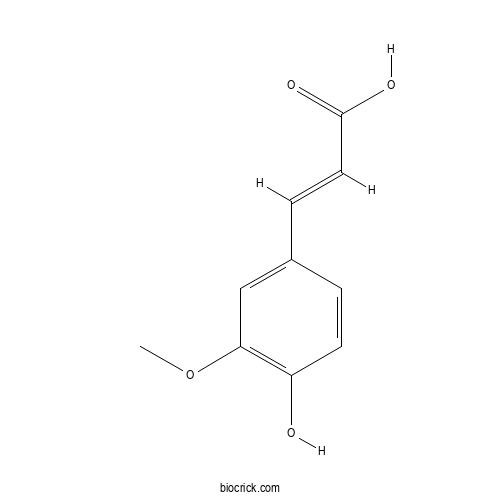trans-Ferulic acidCAS# 537-98-4 |

- Ferulic acid
Catalog No.:BCN5948
CAS No.:1135-24-6
Quality Control & MSDS
3D structure
Package In Stock
Number of papers citing our products

| Cas No. | 537-98-4 | SDF | Download SDF |
| PubChem ID | 445858 | Appearance | Light yellow powder |
| Formula | C10H10O4 | M.Wt | 194.18 |
| Type of Compound | Phenylpropanes | Storage | Desiccate at -20°C |
| Synonyms | Coniferic acid; 4-Hydroxy 3-methoxy trans-cinnamic acid | ||
| Solubility | Soluble in diethyl ether, ethanol, ethyl acetate, methanol and hot water | ||
| Chemical Name | (E)-3-(4-hydroxy-3-methoxyphenyl)prop-2-enoic acid | ||
| SMILES | COC1=C(C=CC(=C1)C=CC(=O)O)O | ||
| Standard InChIKey | KSEBMYQBYZTDHS-HWKANZROSA-N | ||
| Standard InChI | InChI=1S/C10H10O4/c1-14-9-6-7(2-4-8(9)11)3-5-10(12)13/h2-6,11H,1H3,(H,12,13)/b5-3+ | ||
| General tips | For obtaining a higher solubility , please warm the tube at 37 ℃ and shake it in the ultrasonic bath for a while.Stock solution can be stored below -20℃ for several months. We recommend that you prepare and use the solution on the same day. However, if the test schedule requires, the stock solutions can be prepared in advance, and the stock solution must be sealed and stored below -20℃. In general, the stock solution can be kept for several months. Before use, we recommend that you leave the vial at room temperature for at least an hour before opening it. |
||
| About Packaging | 1. The packaging of the product may be reversed during transportation, cause the high purity compounds to adhere to the neck or cap of the vial.Take the vail out of its packaging and shake gently until the compounds fall to the bottom of the vial. 2. For liquid products, please centrifuge at 500xg to gather the liquid to the bottom of the vial. 3. Try to avoid loss or contamination during the experiment. |
||
| Shipping Condition | Packaging according to customer requirements(5mg, 10mg, 20mg and more). Ship via FedEx, DHL, UPS, EMS or other couriers with RT, or blue ice upon request. | ||

trans-Ferulic acid Dilution Calculator

trans-Ferulic acid Molarity Calculator
| 1 mg | 5 mg | 10 mg | 20 mg | 25 mg | |
| 1 mM | 5.1499 mL | 25.7493 mL | 51.4986 mL | 102.9972 mL | 128.7465 mL |
| 5 mM | 1.03 mL | 5.1499 mL | 10.2997 mL | 20.5994 mL | 25.7493 mL |
| 10 mM | 0.515 mL | 2.5749 mL | 5.1499 mL | 10.2997 mL | 12.8747 mL |
| 50 mM | 0.103 mL | 0.515 mL | 1.03 mL | 2.0599 mL | 2.5749 mL |
| 100 mM | 0.0515 mL | 0.2575 mL | 0.515 mL | 1.03 mL | 1.2875 mL |
| * Note: If you are in the process of experiment, it's necessary to make the dilution ratios of the samples. The dilution data above is only for reference. Normally, it's can get a better solubility within lower of Concentrations. | |||||

Calcutta University

University of Minnesota

University of Maryland School of Medicine

University of Illinois at Chicago

The Ohio State University

University of Zurich

Harvard University

Colorado State University

Auburn University

Yale University

Worcester Polytechnic Institute

Washington State University

Stanford University

University of Leipzig

Universidade da Beira Interior

The Institute of Cancer Research

Heidelberg University

University of Amsterdam

University of Auckland

TsingHua University

The University of Michigan

Miami University

DRURY University

Jilin University

Fudan University

Wuhan University

Sun Yat-sen University

Universite de Paris

Deemed University

Auckland University

The University of Tokyo

Korea University
- Euphorbol
Catalog No.:BCN0321
CAS No.:566-14-3
- Ethyl trans-caffeate
Catalog No.:BCN0320
CAS No.:66648-50-8
- (+/-)-Eriodictyol
Catalog No.:BCN0319
CAS No.:4049-38-1
- Echinatine N-oxide
Catalog No.:BCN0318
CAS No.:20267-93-0
- Diosmetin 7-glucuronide
Catalog No.:BCN0317
CAS No.:35110-20-4
- 2',6'-Dihydroxy 4',4-dimethoxychalcone
Catalog No.:BCN0316
CAS No.:94441-99-3
- Dihydroavenanthramide D
Catalog No.:BCN0315
CAS No.:697235-49-7
- 23-epi-26-Deoxyactein
Catalog No.:BCN0314
CAS No.:501938-01-8
- 5,6-Dehydro 7,8-dihydrokavain
Catalog No.:BCN0313
CAS No.:3155-51-9
- Cycloartenol
Catalog No.:BCN0312
CAS No.:469-38-5
- trans-Coutaric acid
Catalog No.:BCN0311
CAS No.:27174-07-8
- trans-p-Coumaric acid
Catalog No.:BCN0310
CAS No.:501-98-4
- Fukinolic acid
Catalog No.:BCN0323
CAS No.:50982-40-6
- Grindelic acid
Catalog No.:BCN0324
CAS No.:1438-57-9
- (Rac)-Hesperetin
Catalog No.:BCN0325
CAS No.:69097-99-0
- 3'-Hydroxyflavone
Catalog No.:BCN0326
CAS No.:70460-18-3
- Hyperforin (stable Dicyclohexylammonium salt)
Catalog No.:BCN0327
CAS No.:238074-03-8
- Isomenthone
Catalog No.:BCN0328
CAS No.:491-07-6
- Isoxanthohumol
Catalog No.:BCN0329
CAS No.:521-48-2
- Lactucin
Catalog No.:BCN0330
CAS No.:1891-29-8
- Lavandulol
Catalog No.:BCN0331
CAS No.:58461-27-1
- Lavandulyl acetate
Catalog No.:BCN0332
CAS No.:25905-14-0
- (+)-Lupanine hydrochloride
Catalog No.:BCN0333
CAS No.:1025-39-4
- 6-Methoxytricin
Catalog No.:BCN0334
CAS No.:76015-42-4
Pediococcus Pentosaceus from the Sweet Potato Fermented Ger-Minated Brown Rice Can Inhibit Type I Hypersensitivity in RBL-2H3 Cell and BALB/c Mice Models.[Pubmed:34576749]
Microorganisms. 2021 Aug 31;9(9). pii: microorganisms9091855.
In this study, the effect of GBR fermented with the Pediococcus pentosaceus SP024 strain on IgE/Ag mediated passive cutaneous anaphylaxis (PCA) was investigated. Protocatechuic acid and trans-Ferulic acid levels in GBR-SP024 increased more than those in unfermented GBR, respec-tively. The inhibitory activity of GBR-SP024 on beta-hexosaminidase release and the level of proin-flammatory cytokine mRNA expression (tumor necrosis factor-alpha (TNF-alpha) and interleukin 4 (IL-4)) was observed in IgE/Ag-stimulated RBL-2H3 cells. Western blot analysis showed that GBR-SP024 significantly inhibited the phosphorylation of the linker for activation of T cell (LAT) and nuclear factor-kappaB (NF-kappaB) in IgE/Ag-stimulated RBL-2H3 cells. Further, we investigated the anti-allergic effect of GBR-SP024 using PCA murine model. The number of infiltrated immune cells and degranulated mast cells in GBR-SP024 treated dermis was lower than that in the GBR-treated mice. In addition, mRNA expression of 5-lipoxygenase (5-LOX) in the dermis of ear tissue declined in the GBR-SP024-treated group, compared to that in the GBR group. GBR-SP024 was also more effective than GBR at reducing the levels of IL-33 protein expression in IgE/Ag-stimulated BALB/c mice. Our study suggests the potential usage of GBR-SP024 as a dietary supplement or an adjuvant for treating IgE-dependent-allergic diseases.


